Photo

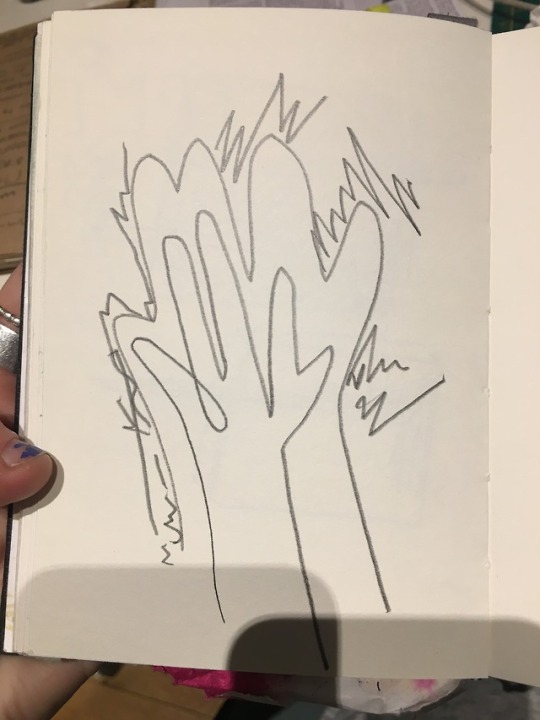
(top) The leftover imprint of my sticky sandy glove within a small pile of sand on my desk, (bottom) a sketch by me of a little made up idea on the bus.
I think it’s nice how this image leaves a trace of the artist’s hand within the artist’s material.
I think it would be cool to allow the viewer to place their hand within this form if it meant that they could feel the material texture beneath them and around their hand. However, could this be a little bit too literal in terms of “the artist’s hand”?
1 note
·
View note
Video
youtube
Human Elevator, Gelitin, 2016, Parallel Vienna
I think this is bloody genius.
Gelitin, an art collective from Austria are well known for working with the community around them to create socially engaged works. in 2016, they presented this piece as the only way to enter the exhibition ahead; being passed upwards through the groups' hands. I think it represents strongly similar ideas of audience accessibility as I attempt to in my work, but most importantly, the key to this work is that it cannot be anything without the audience. By basing the work’s existence on viewer participation, the role of the artist is fully erased, and artist and audience become one creative collective. This work also demonstrates how work placed in the public realm can achieve this inclusivity very easily. Though I wonder if placing my work in somewhere public would help this idea in my case too, I feel that the participation would be hard to encourage. What works so successfully in ‘Human Elevator’ is that the audience has to participate to actually access the rest of the works, so I wonder what sort of things I could put in place to make clear that participation was needed in the work.
0 notes
Photo
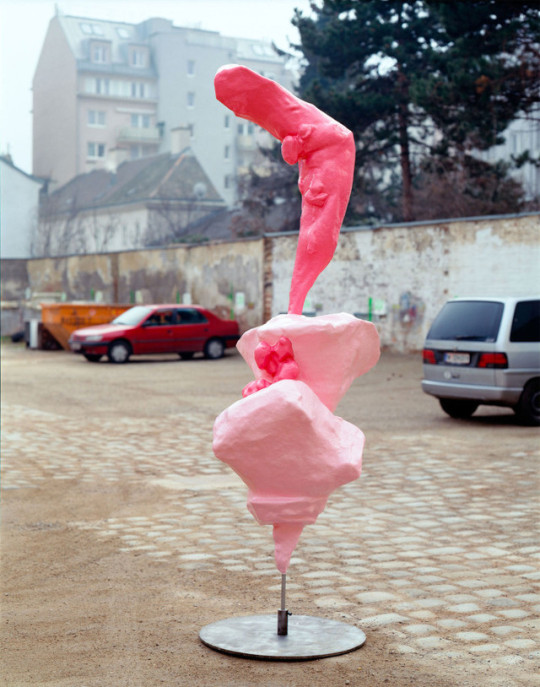
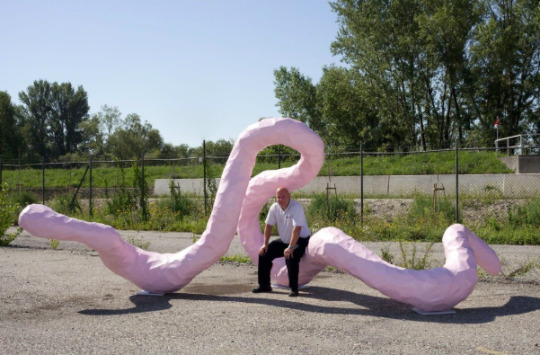
(top) Franz West, Untitled, 2007, (bottom) Franz West, Untitled, 2012
I think it is interesting how Franz West presents a big F you to the idea of the Artwork as an elevated mastered object on a plinth.
Franz West, working primarily in sculpture, though creating through the language of painting, appears to put this idea of the painted object at the forefront of his work. His works feature bright colours and interesting materials, usually large scale and bold in their display placement, his works seem to not take themselves too seriously, and through this shines through his aim to make them openly accessible to the viewer. This is what most strongly attracts me to his works; as he allows the viewer to use his sculpture as a bench, or places it within their own environment outside of the traditional gallery space (as seen above), he allows the painted object to become something that belongs to the audience’s world. I share this aim, trying to make my work more accessible to my viewer in order to help them understand the materiality in a deeper way. In my crit group peice that I made, I allowed the viewers to paint their own abstract images within the sand on the gallery floor. West appears to play around with the elitist system of fine art through his displays, and I suppose it could be argued that I am doing a similar thing, toying with the idea of the artist as a raised creative figure, and letting this role go to the audience instead.
0 notes
Photo

Photo from the ‘Arte Povera & Azoni Povere’ exhibition in Amalfi, Italy in 1968.
This exhibition is often held as the founding moment of the Arte Povera movement, when a group of young collectors asked Germano Celant to curate an artistic event. It was put on at a time when art had no ambition and was purely driven by the market, but this exhibition presented an experimental logic of artworks.
0 notes
Photo

Germano Celant’s ‘Arte Povera’ manifesto. (in Italian)
I think that going forward from seeing Barlow’s exhibition, it seems appropriate to look at one of her main influences, the Arte Povera movement.
Taking place in the late 60′s -70′s, this was a movement that completely disrupted the value of the gallery system at the time, and translating literally to ‘poor art’, favoured throwaway and unconventional materials over traditional ones. Lead by Germano Celant, who coined the term in 1967, artists were encouraged to make art without the restraints of tradition. I can see a relation to my choice of sand as my leading material, something that is not only accessible but also low in status, being essentially part of the dirt and earth. It is clear to see this influence in the work of Barlow, not only in her use of materials, but also in the ways she challenges the traditional ideas surrounding them and the concept of large-scale, installation works.
0 notes
Photo
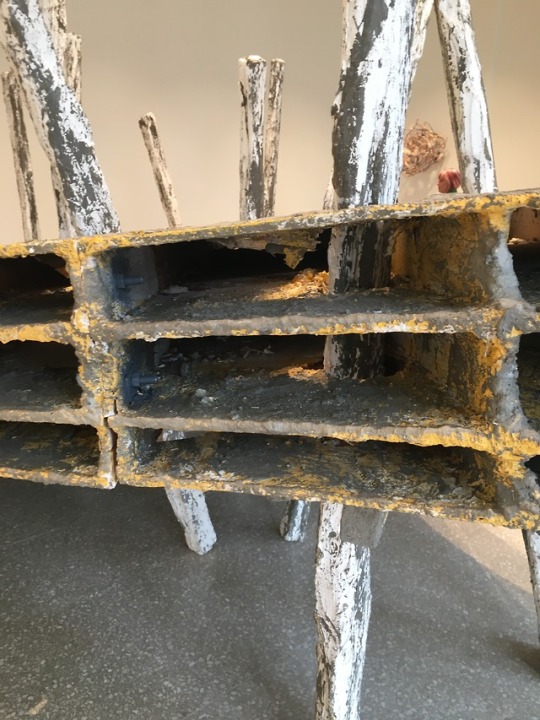


Details from some of the works from ‘Phyllida Barlow: cul-de-sac’ at the RA.
I think Barlow’s demanding and physical processes of making remain evident the textural details across her works.
0 notes
Video
The Physical, Terrifying Boldness of Phyllida Barlow | Brilliant Ideas E...
0 notes
Photo
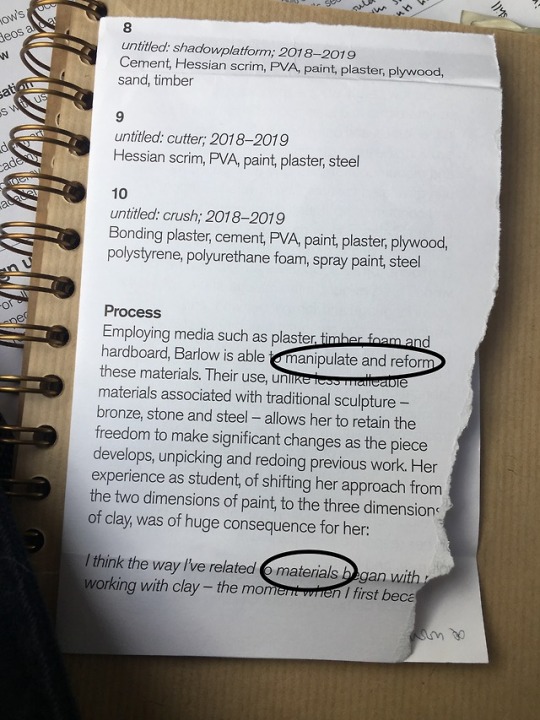
Detail from the press release for ‘Phyllida Barlow: cul-de-sac’ at the RA.
0 notes
Photo
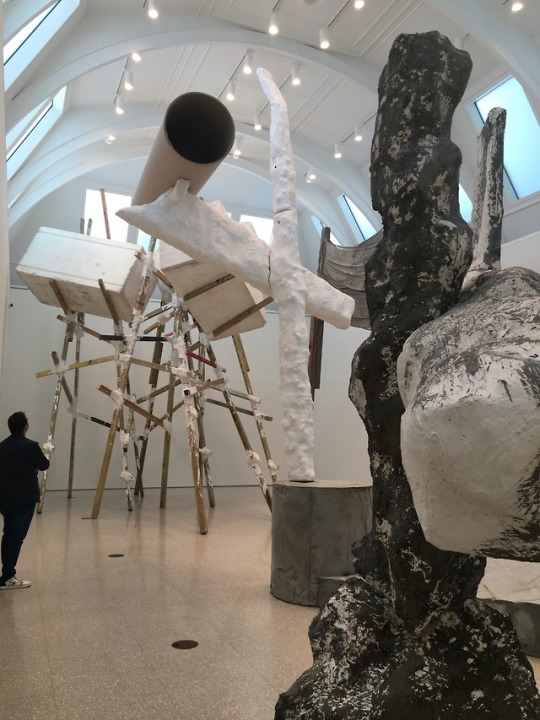
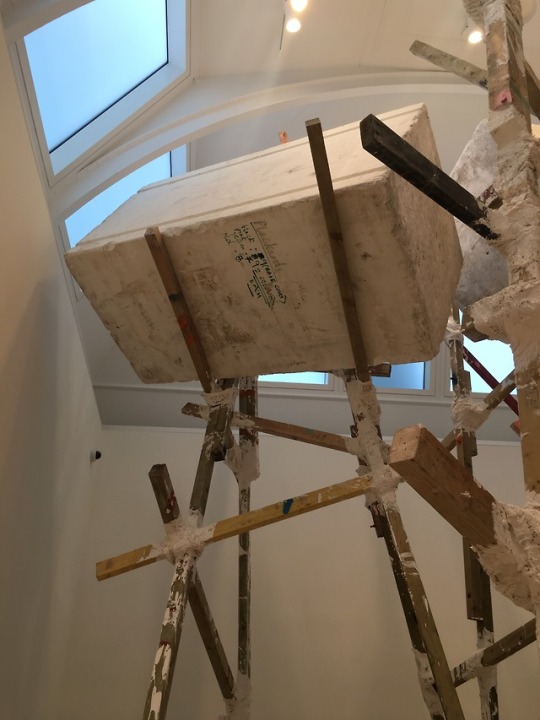
My photos from Phyllida Barlow’s recent exhibition at the RA.
I think I have never seen someone who displays such strong exploration of material and process in her work.
Before this exhibition, I had seen Barlow’s work around online, and had actually seen her represent Britain at the Venice Biennale, but I had never given her much attention, or taken the time to properly view her work. So, needless to say, this collection was unbeleivably enlightening for me. as her works dominated the exhibition spaces, she presents monumental displays of material experimentations. With the often times raw and exposed material, they command the room with their strong sense of the physical act of making. As I walk through and under the works, I feel as if I can still feel the artists’ hands on their surfaces, with writing from the artist left on some components, creating an effect similar to the remnants of the artist’s hand in a Pollock work. In her film, ‘Phyllida’, Barlow speaks of being attracted to a work that is bigger than herself, one that dominates her space, providing a dramatic reveal of the artists process. Yet, though Barlow appears to accept and utilise the dominance of space that comes with making large-scale works, her installations hold a sense of fragility, as if balancing precariously, and as her press release suggests, this seems to challenge ‘the ideas of monumentality and authority associated with traditional sculptural materials and methods’. By suggesting a weaker, more precarious nature to the traditionally strong materials of Timber, plaster, and hardboard, Barlow creates a conversation of juxtaposition between the materials themselves, challenging their expected properties. She seems to be an artist who pushes the exploration of material to the absolute maximum, not only testing and utilising their properties, but manipulating them. While I wonder if I have exhausted my material of sand, I wonder if there is a way for me to change the way I am using it and considering it as a material, in order to push it further.
0 notes
Photo
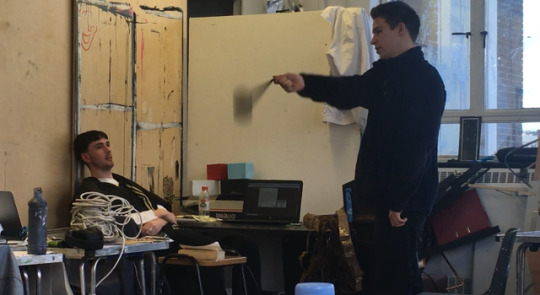
Screenshot from a video taken of Patrick and Laurie playing with one of my sand sausages in the studio.
I think boys have a strange attraction to these weird sand forms I’ve made.
I don’t know whether this is because the boys on this art course are just keen to get involved with having fun with peoples works in the studio, or if there is just some weird concept to do with the scrotum-like appearance of the forms?? Either way, it is nice to observe people being interested in handling them, particularly as this is an idea I am considering when it comes to my fmp.
0 notes
Quote
the true locus of writing is reading.
The Death of the Author, Robert Barthes
I think this suggestion that the position of writing is based originally in the position of receiving a literary work can be translated into my practice easily.
It can help argue that every artist starts as just a viewer, and constant inspiration is taken from other works around them. By giving a work a singular meaning and refusing the audience the right to think otherwise, you also refuse the work the role of inspiration, as viewers are limited in what they can take from it. If I follow fully what the essay argues, I could suggest that the artist should instead go through a process of letting go of the work, allowing the viewer control over the meaning.
“To give an author to a text is to impose upon that text a stop clause, to furnish it with a final signification, to close the writing.” - The Death of the Author, Robert Barthes
0 notes
Photo

My hands covered a crusty mess after playing around with sand and pva.
I think its nice how the image reminds me of the process and how the sandy ball felt in my hands to form.
0 notes
Quote
Making the narrator not the person who has seen or felt, not even the person who writes, but the person who will write
The Death of the Author, Roland Barthes
I think this is an interesting idea; the prospect of allowing not the artist or the viewer to be the most important recipient of the work, but the next line of creators.
0 notes
Photo

‘Sunflower seeds’, Ai Weiei, 2010
I think Weiwei’s work here, composed of 100 million porcelain ‘seeds’ filling the Turbine Hall can be helpful to me in terms of the way that he forces viewer involvement by covering their space in the work.
Placed “on the verge between activism and art”, he makes a comment on mass production, but by allowing the viewer to get fully within the installation and feel every little seed, he opens up a new branch of understanding to the work. Similarly, by allowing the viewer to feel and handle my material of sand, I think it will encourage a deeper understanding of not only its properties but also my explorations, bringing my process to become part of the final work.
0 notes
Photo

I think this type of art could really help me understand and explain better my motives behind my drive for audience participation.
The drive behind socially engaged art is one that the idea of audience participation lies heavily within. I think that within my work, I can use this to help the viewer understand the materiality and my explorations more, as they can collaborate with me in them.
0 notes
Photo
I think this very dedicated use of the unconventional material of pollen to form a large, colour blocked image in this installation is quite an encouraging exploration of material for me. I wonder how I could introduce colour myself into my work, perhaps dying the sand?


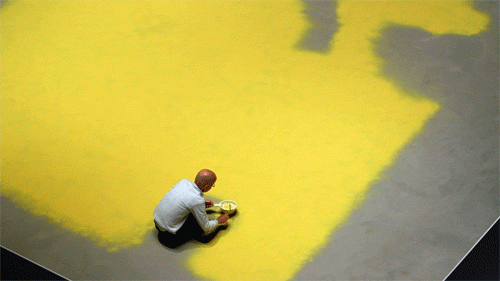
Wolfgang Laib installed his work ‘Pollen From Hazelnut,’ with pollen harvested by hand over 20 years, at the Museum of Modern Art in New York.
3K notes
·
View notes
